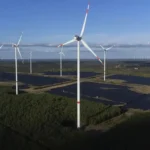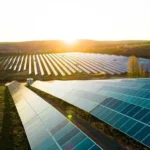Bioenergy is rapidly emerging as one of the most promising sources of renewable energy. As global demand for clean energy solutions continues to rise, bioenergy has garnered significant attention for its potential to mitigate climate change, reduce dependence on fossil fuels, and foster economic growth. Defined as energy derived from organic materials, bioenergy plays a pivotal role in transitioning from conventional energy sources to more sustainable, environmentally friendly alternatives. This sector encompasses a variety of processes and technologies, such as biofuels, biomass power plants, and waste-to-energy systems, each of which offers unique environmental and economic benefits.
In this article, we will explore the latest advancements in bioenergy development, including key biofuel innovations, breakthroughs in bioenergy technology, and the promising future of bioenergy. We will also address the challenges the bioenergy industry faces and the opportunities it offers, particularly in creating jobs, stimulating rural economies, and reducing carbon emissions. By examining these developments, we aim to provide a comprehensive understanding of the transformative role bioenergy can play in shaping a more sustainable future.
The environmental significance of bioenergy is immense. Unlike coal, oil, and natural gas, bioenergy production can be carbon neutral, meaning it can offset carbon emissions through natural processes like photosynthesis. Moreover, bioenergy technologies can help reduce waste by converting agricultural, industrial, and household waste into valuable energy resources, ultimately contributing to a circular economy.
Economically, bioenergy has the potential to create jobs, stimulate rural development, and foster economic growth in local communities. With growing concerns over energy security and the need for sustainable alternatives, the future of bioenergy looks increasingly promising as governments, businesses, and research institutions invest in biofuel innovations and technologies.
Over the past decade, significant strides have been made in bioenergy technology. From algae-based biofuels to waste-to-energy systems, these developments are paving the way for a more sustainable energy future. Let’s delve into some of the most notable advancements in the bioenergy sector.
Algae-based biofuels represent one of the most promising biofuel innovations in recent years. Algae have the ability to produce large amounts of oils that can be converted into biodiesel, a renewable alternative to traditional diesel fuels. Algae also have the advantage of growing rapidly in various environments, including saltwater, wastewater, and even desert regions, making them a versatile and scalable source of biofuel.
Several companies and research institutions are working on making algae-based biofuels commercially viable by improving cultivation methods and refining the conversion process. Recent breakthroughs in algae genetics and metabolic engineering have made it possible to produce biofuels more efficiently. As algae-based biofuels continue to advance, they hold the potential to become a cornerstone of sustainable bioenergy solutions, reducing our reliance on fossil fuels and mitigating greenhouse gas emissions.
Biomass power plants are another key development in bioenergy technology. These plants convert organic materials, such as wood chips, agricultural residues, and food waste, into heat and electricity. Biomass energy is one of the oldest forms of renewable energy, but recent technological advancements have made it more efficient and cleaner than ever before.
Modern biomass power plants use advanced combustion technologies to maximize energy output while minimizing emissions. Additionally, some plants are adopting combined heat and power (CHP) systems, which improve efficiency by simultaneously producing electricity and useful heat. This makes biomass power an attractive solution for both electricity generation and heating in industrial and residential sectors.
Waste-to-energy (WTE) technologies have also seen significant progress in recent years. These systems convert non-recyclable waste materials, such as plastics, paper, and municipal solid waste, into electricity, heat, or biofuels. WTE technologies help address two pressing global issues: waste management and the need for clean energy.
One of the most promising advancements in WTE technology is the development of anaerobic digestion processes, which break down organic waste to produce biogas. This biogas can be used to generate electricity or fuel vehicles, reducing the environmental impact of landfill waste while creating valuable energy resources. Moreover, WTE systems can be integrated with existing waste management infrastructures, providing an efficient solution to the growing global waste crisis.
CCS technologies capture carbon dioxide (CO2) emissions from bioenergy production facilities and store them underground or convert them into useful products, such as chemicals or building materials. By integrating CCS with bioenergy systems, it is possible to achieve negative emissions, effectively removing more CO2 from the atmosphere than is released. This approach has the potential to play a crucial role in combating climate change while allowing bioenergy to remain a sustainable energy source.
While the bioenergy sector has made significant progress, it still faces several challenges that must be addressed to realize its full potential. These include high production costs, scalability issues, and the need for supportive government policies.
The production of biofuels, particularly algae-based biofuels and advanced biomass fuels, remains expensive. High production costs are one of the main barriers to large-scale adoption of these technologies. Additionally, the scalability of bioenergy projects, especially in developing regions, is limited by factors such as feedstock availability, infrastructure, and funding.
To overcome these challenges, ongoing research is focused on improving production efficiency, reducing feedstock costs, and optimizing conversion processes. Additionally, governments and private investors must collaborate to create financial incentives and policies that promote bioenergy development on a global scale.
Bioenergy development presents significant opportunities for job creation, particularly in rural areas. Bioenergy projects, such as biomass power plants and algae farms, require a diverse workforce for cultivation, harvesting, processing, and transportation. This can lead to the creation of thousands of jobs in rural communities, helping to revitalize local economies and improve livelihoods.
Moreover, bioenergy has the potential to reduce energy costs for rural and remote areas, which often face high energy prices due to reliance on imported fossil fuels. By investing in bioenergy infrastructure, governments can help create a more resilient and self-sustaining energy system.
The environmental benefits of bioenergy are perhaps its most compelling advantage. Bioenergy offers a pathway to significantly reduce carbon emissions by replacing fossil fuels with cleaner, renewable energy sources. Additionally, bioenergy technologies like waste-to-energy systems and algae-based biofuels can help reduce waste, further contributing to environmental sustainability.
As the world grapples with climate change, bioenergy’s role in mitigating greenhouse gas emissions becomes increasingly important. By advancing bioenergy technologies and scaling up their deployment, we can reduce our reliance on fossil fuels and take meaningful steps toward achieving global climate goals.
The future of bioenergy looks promising as governments, businesses, and researchers continue to invest in new technologies and solutions. Policymakers are increasingly recognizing the potential of bioenergy to reduce carbon emissions, create jobs, and enhance energy security. As a result, bioenergy development is expected to play a key role in future energy systems.
In addition to technological advancements, market trends indicate that bioenergy will continue to expand as a sustainable alternative to traditional energy sources. As fossil fuel prices rise and the environmental costs of their use become more apparent, bioenergy will become an increasingly attractive option for both consumers and industry stakeholders.
In conclusion, bioenergy development represents a critical element of our transition to a more sustainable and energy-efficient future. From algae-based biofuels to waste-to-energy technologies, recent innovations in bioenergy are pushing the boundaries of what is possible in the renewable energy sector. While challenges remain, the opportunities presented by bioenergy are vast, particularly in terms of job creation, rural development, and carbon emissions reduction.
As we look to the future, bioenergy will continue to play a central role in global efforts to combat climate change, reduce dependence on fossil fuels, and create a cleaner, more sustainable energy future. By embracing bioenergy technology and supporting its development, we can unlock a wide range of benefits for the environment, the economy, and future generations.












